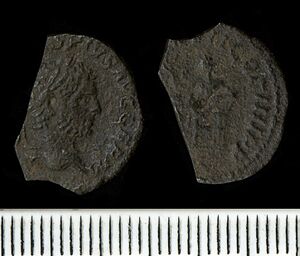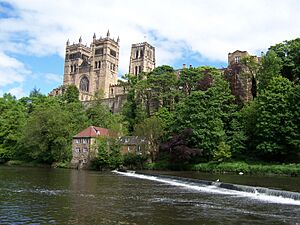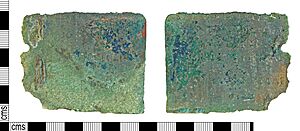Durham University Museum of Archaeology facts for kids
 |
|
| Lua error in Module:Location_map at line 420: attempt to index field 'wikibase' (a nil value). | |
| Former name | Durham University Museum |
|---|---|
| Established | 1833 |
| Location | Palace Green, Durham, England |
| Type | University archaeology museum |
| Accreditation | UK Museum Accreditation Scheme, Arts Council England |
| Key holdings | Oswald-Plique collection, Lanchester diploma |
| Collections | Prehistoric, Ancient Greek, Roman, early medieval, medieval, post-medieval |
| Visitors | 30000 |
| Owner | Durham University |
The Museum of Archaeology is a cool place to discover history! It's the archaeology museum for Durham University in England. It first opened in 1833. This made it the second university museum in England that the public could visit.
The museum mainly shows off archaeological finds from north east England. But it also has some amazing items from other parts of the country and even from around the world. Its collections cover a huge span of time, from prehistoric times all the way to the post-medieval period.
Some of its most special items include the Oswald-Plique collection of Samian ware (a type of Roman pottery). It also has the first complete Roman fleet diploma ever found in Britain. A diploma was like an official certificate given to Roman soldiers. The museum also keeps archaeological finds from building projects in Durham City. These are called "development-led archaeology" finds.
The Museum of Archaeology is part of a bigger group called Durham University Museums, Galleries and Exhibitions. This group also includes the Durham Castle Museum and the Durham University Oriental Museum.
Contents
History of the Museum
The Museum of Archaeology has moved around a bit over the years! Let's explore its journey.
Early Days and First Home
When Durham University first opened in 1833, its museum found a home in the Old Fulling Mill. This old mill was right on the River Wear, below Durham Cathedral. It was a big deal because it was only the second university museum in England to welcome the public.
In its early years, the museum had a wide variety of items. It included many natural history specimens, like a large collection of British birds. These were often given by people like Thomas Gisborne. The museum also had Roman artifacts found at a place called Binchester.
Moving and Changing Collections
In 1876, the museum moved to Bishop Cosin's Almshouses on Palace Green. By 1892, a magazine called The Antiquary praised the Binchester collection. They said it was "of first-class archaeological value." However, they also felt the museum as a whole "reflects no credit on the University of Durham." This meant they thought the museum could be much better.
When World War I started, the university's lecture halls were needed for other things. So, the museum building was turned into a temporary lecture hall. Since the building wasn't ideal for a museum anyway, they decided to sort through the collection. They got rid of items that weren't very useful for education. Other items were moved to places where they would be more helpful. For example, the bird collection went to St Hild's College. Scientific items went to science labs. The Binchester collection moved to a room used for history lectures. Other objects went to the university library.
New Focus on Archaeology
In 1931, Eric Birley became the university's first lecturer in archaeology. He added many items to the teaching collection from his digs at Hadrian's Wall. This helped the museum focus more on archaeology.
In 1975, the museum reopened in the Old Fulling Mill. Now, it was completely focused on archaeology. More display areas were added in 1986. However, this location had problems. It was often flooded and was not in a main tourist area.
Return to Palace Green
In 2014, the museum moved back to Palace Green. It found a new home in the Wolfson Gallery, which is part of the Durham University Library complex. Since 2021, the museum's research collections have been stored in a different location.
Museum Collections
The museum has an amazing range of items from different time periods. These include objects from the prehistoric age, Ancient Greek times, Roman times, the early medieval period, the medieval period, and the post-medieval period.
Key Artifacts and Discoveries
Some of the most interesting items you can see include:
- The Houghall Sword: This is a Bronze Age sword. It's a type called an Ewart Park sword, dating from about 700–900 BC. It was found in 1996 near Durham.
- The Oswald-Plique Collection: This is a huge collection of over 4,500 pieces of Samian ware. This Roman pottery collection is very important around the world. It was bought by Eric Birley in 1950. It has been used as a reference for important books about Roman pottery.
- Roman Artifacts: The museum has Roman items from old digs at Binchester. It also has finds from Eric Birley's work in the 1930s at Benwell on Hadrian's Wall.
- The Lanchester Diploma: This is the first complete Roman fleet diploma ever found in Britain. It was discovered in Lanchester, County Durham, by someone using a metal detector in 2016.
Local Archaeological Finds
Most of the museum's collection comes from "development-led archaeology." This means items found during building work in Durham City and nearby areas. The museum is where these important finds are kept.
For example, they have bone fragments of Durham's earliest known resident. These bones were found in 2016–17 during construction for student homes. Scientists used carbon dating to figure out that these bones are from between 90 BC and 60 AD!
The museum also has one of the UK's largest collections of post-medieval glass. This includes over 100 bottles from the 17th and 18th centuries. These were found during earlier digs in the 1990s.

Other special collections include:
- The Piercebridge River Assemblage: This collection has over 4,000 Roman artifacts. They were found where Dere Street (an old Roman road) crossed the River Tees. People think these were mostly offerings thrown into the river from the bridges.
- The Durham River Wear Assemblage: This is an even bigger collection with over 13,500 objects! These were found in the River Wear below the 12th-century Elvet Bridge. This collection was even featured in a special exhibition in 2023.
- The museum also holds archives and finds from the Durham City Survey, which helps us understand the city's past.



